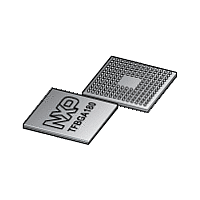LPC2458 NXP Semiconductors, LPC2458 Datasheet - Page 21

LPC2458
Manufacturer Part Number
LPC2458
Description
NXP Semiconductors designed the LPC2458 microcontroller around a 16-bit/32-bitARM7TDMI-S CPU core with real-time debug interfaces that include both JTAG andembedded trace
Manufacturer
NXP Semiconductors
Datasheet
1.LPC2458.pdf
(80 pages)
Available stocks
Company
Part Number
Manufacturer
Quantity
Price
Company:
Part Number:
LPC2458FET180
Manufacturer:
NXP
Quantity:
387
Company:
Part Number:
LPC2458FET180
Manufacturer:
NXP
Quantity:
80 000
Part Number:
LPC2458FET180
Manufacturer:
NXP/恩智浦
Quantity:
20 000
Company:
Part Number:
LPC2458FET180,551
Manufacturer:
MICROCHIP
Quantity:
1 103
Company:
Part Number:
LPC2458FET180,551
Manufacturer:
NXP Semiconductors
Quantity:
10 000
NXP Semiconductors
LPC2458
Product data sheet
7.2 On-chip flash programming memory
The second AHB, referred to as AHB2, includes only the Ethernet block and an
associated 16 kB SRAM. In addition, a bus bridge is provided that allows the secondary
AHB to be a bus master on AHB1, allowing expansion of Ethernet buffer space into
off-chip memory or unused space in memory residing on AHB1.
In summary, bus masters with access to AHB1 are the ARM7 itself, the GPDMA function,
and the Ethernet block (via the bus bridge from AHB2). Bus masters with access to AHB2
are the ARM7 and the Ethernet block.
AHB peripherals are allocated a 2 MB range of addresses at the very top of the 4 GB
ARM memory space. Each AHB peripheral is allocated a 16 kB address space within the
AHB address space. Lower speed peripheral functions are connected to the APB. The
AHB to APB bridge interfaces the APB to the AHB. APB peripherals are also allocated a
2 MB range of addresses, beginning at the 3.5 GB address point. Each APB peripheral is
allocated a 16 kB address space within the APB address space.
The ARM7TDMI-S processor is a general purpose 32-bit microprocessor, which offers
high performance and very low power consumption. The ARM architecture is based on
Reduced Instruction Set Computer (RISC) principles, and the instruction set and related
decode mechanism are much simpler than those of microprogrammed complex
instruction set computers. This simplicity results in a high instruction throughput and
impressive real-time interrupt response from a small and cost-effective processor core.
Pipeline techniques are employed so that all parts of the processing and memory systems
can operate continuously. Typically, while one instruction is being executed, its successor
is being decoded, and a third instruction is being fetched from memory.
The ARM7TDMI-S processor also employs a unique architectural strategy known as
Thumb, which makes it ideally suited to high-volume applications with memory
restrictions, or applications where code density is an issue.
The key idea behind Thumb is that of a super-reduced instruction set. Essentially, the
ARM7TDMI-S processor has two instruction sets:
The Thumb set’s 16-bit instruction length allows it to approach higher density compared to
standard ARM code while retaining most of the ARM’s performance.
The LPC2458 incorporates 512 kB flash memory system. This memory may be used for
both code and data storage. Programming of the flash memory may be accomplished in
several ways. It may be programmed In System via the serial port (UART0). The
application program may also erase and/or program the flash while the application is
running, allowing a great degree of flexibility for data storage field and firmware upgrades.
The flash memory is 128 bits wide and includes pre-fetching and buffering techniques to
allow it to operate at speeds of 72 MHz.
•
•
the standard 32-bit ARM set
a 16-bit Thumb set
All information provided in this document is subject to legal disclaimers.
Rev. 4 — 1 September 2011
Single-chip 16-bit/32-bit micro
LPC2458
© NXP B.V. 2011. All rights reserved.
21 of 80

















